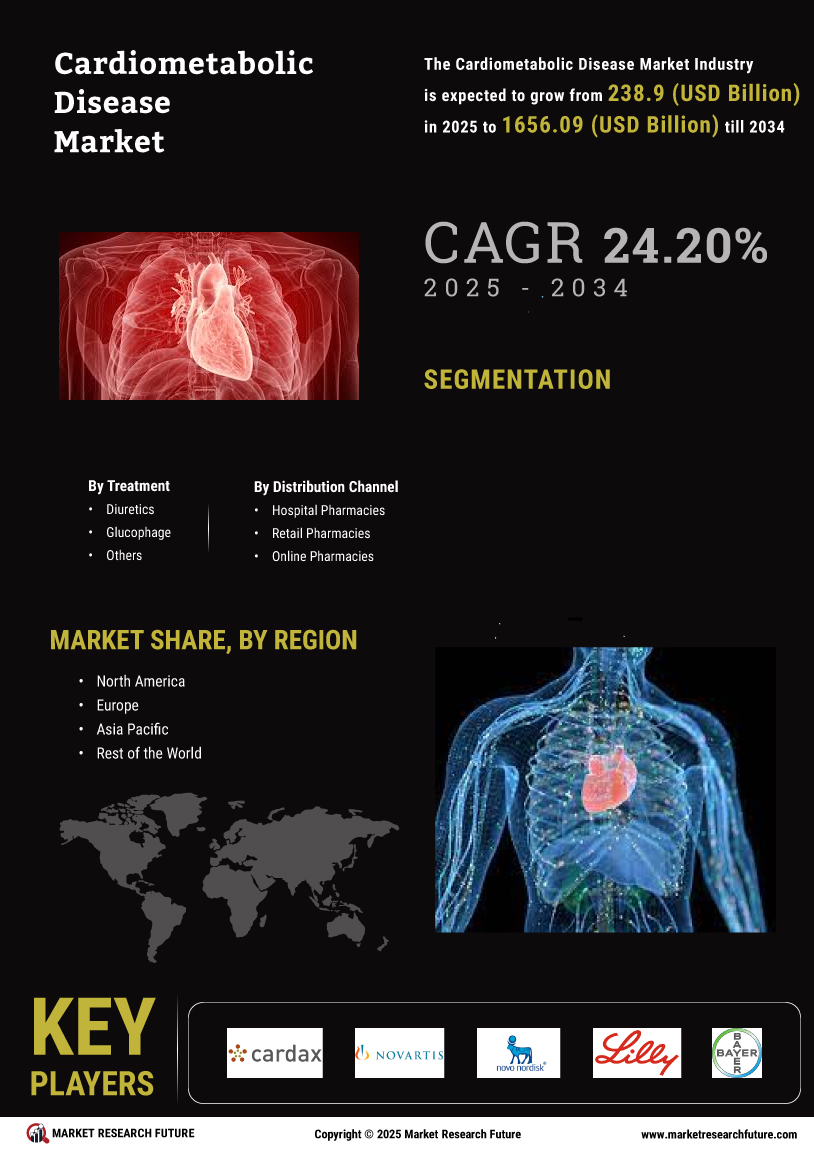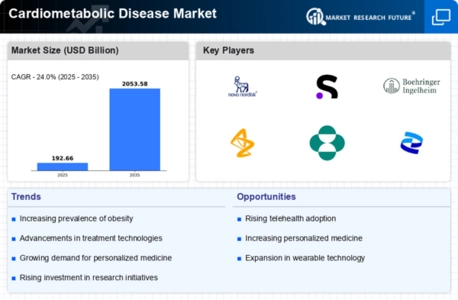Rising Healthcare Expenditure
Escalating healthcare expenditure is a crucial driver of the Cardiometabolic Disease Market. As nations allocate more funds towards healthcare, there is a corresponding increase in investments aimed at addressing cardiometabolic diseases. In many regions, healthcare spending has risen significantly, with projections indicating that it could reach trillions of dollars in the coming years. This financial commitment is likely to facilitate the development of new therapies, diagnostic tools, and preventive measures tailored to combat these disorders. Moreover, increased funding for research initiatives is expected to yield breakthroughs in understanding the underlying mechanisms of cardiometabolic diseases, ultimately leading to more effective treatment options. Consequently, the Cardiometabolic Disease Market stands to benefit from this upward trend in healthcare investment.
Rising Awareness and Education
The growing awareness and education surrounding cardiometabolic diseases are pivotal in shaping the Cardiometabolic Disease Market. Public health campaigns and educational initiatives are increasingly informing individuals about the risks associated with these conditions and the importance of lifestyle modifications. This heightened awareness is likely to drive demand for screening and treatment options, as individuals become more proactive in managing their health. Furthermore, healthcare professionals are also receiving enhanced training on the prevention and management of cardiometabolic disorders, which could lead to improved patient outcomes. As awareness continues to rise, it is anticipated that the market will witness an influx of innovative products and services aimed at addressing the needs of patients with cardiometabolic conditions.
Advancements in Medical Technology
Technological innovations are transforming the landscape of the Cardiometabolic Disease Market. The integration of advanced medical devices, telemedicine, and digital health solutions is enhancing patient management and treatment outcomes. For instance, wearable devices that monitor vital signs and glucose levels are gaining traction among patients with cardiometabolic conditions. These technologies not only facilitate real-time data collection but also empower patients to take charge of their health. Furthermore, the development of artificial intelligence and machine learning algorithms is enabling more accurate risk assessments and personalized treatment plans. As these technologies continue to evolve, they are expected to drive market growth by improving patient adherence to treatment regimens and reducing healthcare costs associated with cardiometabolic diseases.
Growing Focus on Preventive Healthcare
The shift towards preventive healthcare is significantly influencing the Cardiometabolic Disease Market. With an increasing emphasis on early detection and lifestyle modification, healthcare providers are prioritizing preventive strategies to mitigate the risk of cardiometabolic disorders. This trend is reflected in the rising adoption of screening programs and wellness initiatives aimed at identifying at-risk populations. According to recent data, preventive measures can reduce the incidence of type 2 diabetes by up to 58% in high-risk individuals. As a result, healthcare systems are likely to allocate more resources towards preventive care, thereby creating opportunities for market players to develop and promote innovative solutions. This proactive approach not only enhances patient outcomes but also alleviates the long-term economic burden associated with managing chronic diseases.
Increasing Prevalence of Cardiometabolic Disorders
The rising incidence of cardiometabolic disorders, including obesity, diabetes, and cardiovascular diseases, is a primary driver of the Cardiometabolic Disease Market. Recent statistics indicate that nearly 34% of adults are classified as obese, a condition that significantly elevates the risk of developing these disorders. This alarming trend is likely to propel demand for innovative treatment options and preventive measures. As healthcare systems grapple with the burden of these diseases, investments in research and development are expected to surge, fostering advancements in therapeutics and diagnostics. The growing awareness of the link between lifestyle choices and cardiometabolic health further emphasizes the need for effective interventions, thereby stimulating market growth. Consequently, stakeholders in the Cardiometabolic Disease Market are increasingly focusing on developing comprehensive strategies to address this escalating public health challenge.



.webp)
.webp)
.webp)
.webp)
.webp)
.webp)








Leave a Comment